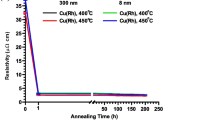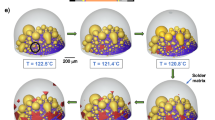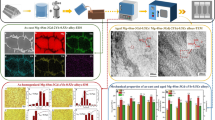Abstract
The effects of trace mount of rare earth elements Pr and Nd addition on Sn–0.3Ag–0.7Cu–0.5Ga lead free solder were investigated by observation of microstructure and the morphology of interface layer, as well as the test of shearing strength of the solder joints. The results show that the microstructure of the solder matrix can be optimized by appropriate addition of Pr and Nd, but the scalloped and “region-like” compounds (IMCs) appear in the solder matrix with excessive Pr and Nd addition respectively which may result in the stress concentration and become the birthplace of the cracks. The behavior of absorption of rare earth elements can retard the interface reaction between solder and Cu substrate, refine the morphology of the interface layer. The shearing strength of the solder joints can be enhanced better with appropriate addition of Pr than Nd by improvement of nucleation rate and control of growth rate of the grains near the interface layer.






Similar content being viewed by others
References
N. Mookam, K. Kanlayasiri, Effect of soldering condition on formation of intermetallic phases developed between Sn–0.3Ag–0.7Cu low-silver lead-free solder and Cu substrate. J. Alloys Compd. 509(21), 6276–6279 (2011)
C.M.L. Wu, D.Q. Yu, C.M.T. Law et al., Properties of lead-free solder alloys with rare earth element additions. Mater. Sci. Eng. R: Rep. 44(1), 1–44 (2004)
D.X. Luo, S.B. Xue, S. Liu, Investigation on the intermetallic compound layer growth of Sn–0.5Ag–0.7Cu-xGa/Cu solder joints during isothermal aging. J. Mater. Sci.: Mater. Electron. 25(12), 5195–5200 (2014)
G. Zeng, S.B. Xue, L. Zhang et al., A review on the interfacial intermetallic compounds between Sn–Ag–Cu based solders and substrates. J. Mater. Sci.: Mater. Electron. 21(5), 421–440 (2010)
M. Reid, J. Punch, M. Collins et al., Effect of Ag content on the microstructure of Sn–Ag–Cu based solder alloys. Solder. Surf. Mt. Technol. 20(4), 3–8 (1989)
A.A. El-Daly, A.E. Hammad, G.S. Al-Ganainy et al., Properties enhancement of low Ag-content Sn–Ag–Cu lead-free solders containing small amount of Zn. J. Alloys Compd. 614(10), 20–28 (2014)
W.X. Chen, S.B. Xue, H. Wang et al., Investigation on properties of Ga to Sn–9Zn lead-free solder. J. Mater. Sci.: Mater. Electron. 21(5), 496–502 (2010)
D.X. Luo, S.B. Xue, Z.Q. Li, Effects of Ga addition on microstructure and properties of Sn–0.5Ag–0.7Cu solder. J. Mater. Sci.: Mater. Electron. 25(8), 3566–3571 (2014)
Q. He, R.G. Ren, X.P. Zhao, Modification of Sn Ag Cu Ga filler metals for electronic packaging. Electron. Packag. 7, 14–15 (2014)
Kang I. Chen, Shou C. Cheng, Chin H. Cheng et al., The effects of gallium additions on microstructures and thermal and mechanical properties of Sn–9Zn solder alloys. Adv. Mater. Sci. Eng. 26(4), 653–659 (2014)
L.L. Gao, S.B. Xue, H. Xu, Microstructure and properties of SnAgCu-xPr solder. Trans. China Weld. Inst. 33(1), 69–72 (2012)
L.L. Gao, S.B. Xue, L. Zhang et al., Effects of trace rare earth Nd addition on microstructure and properties of SnAgCu solder. J. Mater. Sci.: Mater. Electron. 21(7), 643–648 (2010)
P. Xue, S.B. Xue, Y.F. Shen et al., Study on properties of Sn–9Zn–Ga solder bearing Nd. J. Mater. Sci.: Mater. Electron. 21(7), 643–648 (2010)
P. Xue, S.B. Xue, Y.F. Shen et al., Effect of Pr on properties and Sn whisker growth of Sn–9Zn-xPr solder. Solder. Surf. Mt. Technol. 24(4), 280–286 (2012)
X. Chen, J. Zhou, F. Xue et al., Microstructures and mechanical properties of Sn–0.1Ag–0.7Cu-(Co, Ni, and Nd) lead-free solders. J. Mater. Sci.: Mater. Electron. 44(2), 725–732 (2015)
J.D. Luo, S.B. Xue, H. Ye et al., Interfacial microstructure and properties of SnCuNi-xPr/Cu solder joint. Trans. China Weld. Inst. 33(5), 49–54 (2012)
Acknowledgments
The Project was supported by the Key Laboratory of Advanced Welding Technology of Jiangsu Province, China (Foundation No. JSAWT-14-04). This work was also supported by the Fundamental Research Funds for the Central Universities and the Foundation of Graduate Innovation Center in NUAA (Foundation No. kfjj20150604) and this work was also supported by the Priority Academic Program Development of Jiangsu Higher Education Institutions (PAPD).
Author information
Authors and Affiliations
Corresponding author
Rights and permissions
About this article
Cite this article
Han, Y., Xue, S., Yang, J. et al. Effects of trace amount praseodymium and neodymium on microstructure and mechanical properties of Sn–0.3Ag–0.7Cu–0.5Ga solder. J Mater Sci: Mater Electron 27, 351–358 (2016). https://doi.org/10.1007/s10854-015-3761-1
Received:
Accepted:
Published:
Issue Date:
DOI: https://doi.org/10.1007/s10854-015-3761-1




